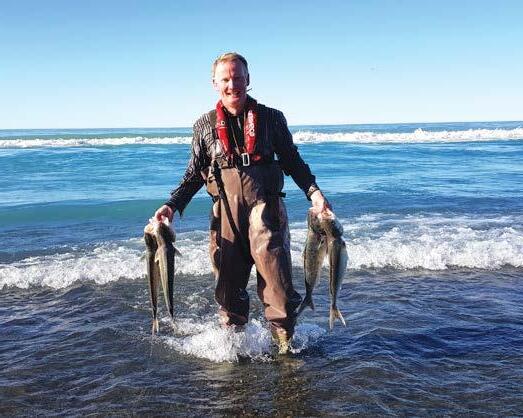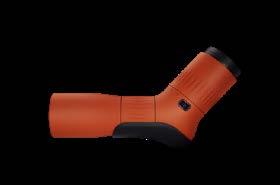THE FISHING PAPER
f ind u s in you r f a vou rit e st o r e o r o nlin e a t th ef ishin gp a pe r. c o .n z



• G iant L an de d
• King f ish w ith ligh t tac k l e
• Speed S t ee l
• W ild Kai in th e W airara p a
• Mainlan d Catch A p p








f ind u s in you r f a vou rit e st o r e o r o nlin e a t th ef ishin gp a pe r. c o .n z



• G iant L an de d
• King f ish w ith ligh t tac k l e
• Speed S t ee l
• W ild Kai in th e W airara p a
• Mainlan d Catch A p p







Sunday, and a sleep in. There’s a dull light behind the curtains and the beginnings of an avian ensemble outdoors before we stir. It’s very nearly winter solstice so the nights are long and cold, the days, snappy cold.
It’s that time of year for mid-winter swims. When ordinarily sensible folk voluntarily immerse themselves, toggedup and goose-bumpy, into frigid lakes and seas. A brisk and invigorating dip to celebrate the coming of spring and summer Me, I try to avoid inundations in anything colder than tepid, but almost inevitably I will end up getting a dousing sometime between June and July. There’s nothing brave or sensible about it, more a case of ‘shit happens’.
After our brief lie-in, it’s time for Hubby and me to venture into the wilderness with our canine besties, each going our separate ways with our separate packs of pig dogs.
I wish, very shortly after starting out I’d not worn the snug winter woollens or the oilskin vest. The steep climb results in free flow sweat on brow, back and bosom. The dogs wear winter coats too but they cannot sweat as I do. I am the lucky one, able to lower a zip
Whilst route planning, I’ve taken into consideration a pig’s need of food and shelter and the warmth of winter sun and after a long walk up through mature pines, my for the dogs seem to have found a promising lead.
Between tended tree trunks I see all
hears the approach of the enemy and has time aplenty to escape Once clear of the gully of wind-throw, he knows every track and trail within his territory He knows how to lose himself and lose those who pursue him too High up here, above the valley floor and amidst the mature pines and filthy gutters
heels, he leaves the hill and deviates for the sanctuary of the river. He and Pearl tumble down the steep embankment and into the torrent. Nugget and Chop have overshot the mark and are momentarily void.
It’s old Pearl on her own then. It’s down to her to prevent the boar from escaping
torrent, their quarry now in plain sight. With panic the boar boosts face. It is insanely steep and dangerous, and there is no escape from here, but nor can his pursuers reach or harm him.

three dogs track into a gully of wind-throw The pig before them has eased through the maze of fallen trunks and branches with its wedge-shaped head and tough snout, its long bristly hair assisting its silent travel. The dogs are not silent. Their bulky tracking collars snag on branches and their travel is punctuated with claws scrabbling, panting and the breaking of branches.
A boar, snoozing deep within the maze,
of barberry and native vines, I can only wait silently and shiver as my sweat-soaked clothing cools.
While I chill, the dogs sizzle - using every ounce of their energy and determination. They have the disadvantage of scent tracking, while their quarry runs without constraint. He has free will, but they have teamwork.
The boar runs a clever route, he is young and fit and strong. The age-old game trails contour across faces, through saddles and below rock outcrops. Sometimes dodging from one trail to the next, other times doubling back. These switchbacks cost him dearly for this morning is still and calm and the dogs hear him as he crashes through the vegetation. Eventually, when the boar can hear a lone dog hard upon his
She manages to catch a hold of him as he clambers out of the torrent and slips on the algae-covered boulders. Here, her paws and claws are
hard-edged hooves. She hocks him, spins him about, then latches onto his hairfringed ear, panting and gasping between clenched teeth.
The boar is heavier than Pearl, and he’s fighting for his life. He and when she comes forward for another round he attacks her,
with his sharp tusks. She hesitates, so he resumes his desperate flight but during the melee he was dragged downstream of his crossing track and now he is in peril.
Sure enough, Chop and Nugget tumble down into the riverbed and forge into the
Still in the forest, so high above, I hear, then see, three white dogs river. Damn!
How am I going to get to them? It’s dangerous steep getting down into the river. It’s dangerous swift getting across the river. Even if I get all my ducks floating in a proverbial row, how the heck am I
going to get the boar out of there?
Just like the boar and dogs before me, I get into the river by tumbling in. Then I get the boar shot and the dogs rewarded. I float the boar back across the frigid and river – a second involuntary mid-winter swim for him and for me. I reckon I can carry him up out of here too, and exertion, but, once I have the shivering dogs back to the warmth and comfort of the dog box, I’ll come back and give it my best shot.
Of course, it would be easier if I had a hand, or better still, a strong man, but what are the chances?
As dogs and I plod back to the ute, I send subliminal messages to Hubby - ‘Come hither big strong fella ’ But, yeah nah, that’d be pushing my luck aye and I’m not a lucky kinda woman. Or am I? Is that a vehicle I see in the far distance? Is it on my side of the river? Is it? It is! Cometh the moment, cometh my man.

We got up bright and early to go fishing around D’Urville Island. I had been begging Mum to take me for ages, so I was excited when she said it was happening and we were taking some good friends with us. It was a cold but beautiful morning.
After launching in Okiwi Bay, we started the long bouncy boat ride to our hopeful kingfish spot, with a
Callum Rees Small
short stop along the way to set up our rods. I had some new lures I was very keen to try After jigging for what felt like forever, suddenly my rod buckled over and the line started peeling out. Excitement ran through my body I kept tightening the drag, but this fish wouldn’t stop Every metre I gained, I lost again in seconds. Finally I stopped the fish running before it
got to the reef - I gave a huge sigh of relief
The fish was clearly getting tired and I was gaining line. However, I knew I had to keep
a long battle, I felt like the fish was finally coming closer to
what felt like one last run, but I managed to hold the fish and eventually saw colour

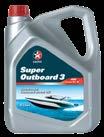



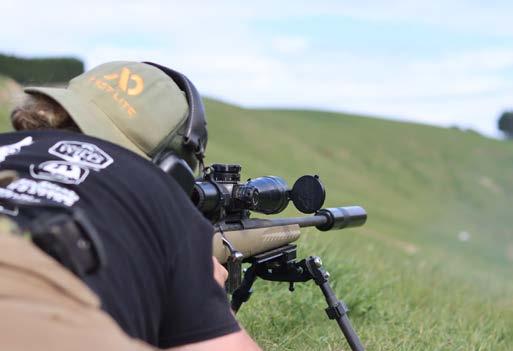
• The first is suitable for 22 Hornet through to 243 including, 222, 223, 22-250, 243.
• The second suppressor is suitable for 6.5 through to 30-06 including 6.5 prc, 270, 7mm-08, 284, 280, 308, 7.62 x 39 etc (not including 300 PRC or belted magnums).
• 9” in length (230mm), sits 4” forward & 5” back over the barrel (this is a “fixed” length and cannot be changed or added to) Weight 360 – 370grams (alu internal muzzlebrake 5-6,000 rnds)
• Colour - Black


kingfish was so big that I struggled to get it in the net my friend was holding - but luckily we
couldn’t believe it, the kingfish was huge - my trying to catch one like this all season. It was so fat. A beast. I was so happy and so were my friends on
the boat with me We were jumping up and
When I looked closely at the kingfish, I realised I was lucky to have landed the beast because it had bite had been attacked by a shark as it got closer to the surface which is sad.
We had a fantastic day. My friends got kingfish too which was awesome. We also got snapper and a trevally on rods, and some blue cod when we went for a dive.
Now I can’t wait for my next chance to go




At its 66th conference in Tauranga on 30 May, the New Zealand Federation of Commercial Fishermen’s annual conference concluded with two well-deserved recognitions –industry stalwart Allan Rooney nabbed the prestigious Electronic Navigation Shield, while Northland fisher Logan Murman landed the inaugural Sunderland Marine Young Fisher of the Year Award.
Greymouth fisher Allan Rooney, who has been working in the industry since the 1970s, has certainly seen his share of changes. Rooney began his fishing career as a part-time deckhand, eventually going full time in 1985, fishing out of Lyttleton for over a decade before returning to the West Coast, where he owns and operates the FV Tanea
from Greymouth in the FV Tanea and - like many others - battles the Greymouth Bar each week in order to provide us with our weekly fix of Friday night fish and chips.

“He has fished out of Grey for the past 50 years, and his knowledge and commitment to the industry cannot be undermined. He’s always there for other fishermen, which played out recently when he took the much larger FV Mako in tow and got vessel and crew across the bar and into port safely Allan is a West Coast pioneer, someone who has run many boats on the Coast and been instrumental in developing many fisheries. True West Coast personality, Roon is the absolute example of a worthy ENL Shield recipient ” Meanwhile, friends and family describe Logan Murman as “very innovative”, “curious” and someone with a “huge work ethic” They paint a picture of a twenty-sevenyear-old who is putting in the hard yards to succeed in his chosen path as a fisher
time spent away from his home port, Murman returned to Leigh and bought the 14.2 metre FV Unity in 2021, which he now skippers, rotating between fishing for crays and longlining for finfish, depending on the season.
It is this innovative mindset that led the awards committee to select Murman as the inaugural winner of the Sunderland Marine Young Fisher of the Year Award.
continuously adjust his fishing methods – for example, by
areas depending on the season or lunar phase to maximise his success,” says Ben Pierce, co-founder of Young Fish and creator of the award.
“They also reference his positive attitude, how good he is to work with and his ongoing contributions to his local fishing communities, all of which are important qualities to nurture throughout your career ”

The award - (a collaboration between Young Fish Aotearoa NZ, founding sponsor Sunderland Marine and the Federation)celebrates the early career achievements and hard work of New Zealand’s fishers under the age of 35.
Murman says he wasn’t expecting to win the award.
“It solidifies the fact that I’m on the right track within my own business and operations – it’s reassuring to know that you’re doing well in the industry you’re in.”
Though he hasn’t decided what he’ll do with the $5,000 scholarship yet, he has a growth mindset for himself and his business.

Ever since the earliest Federation conferences in the late 1950s and early 1960s, the partners of the fishermen have attended their own bespoke tour and itinerary around the region where the conference took place while their fishing partner debated issues of quota, levies or other politics of the day. Many fishers’ partners play an integral role, either at sea or in support ashore with administration operations, which is why the Federation rewards them with a day out in the region.
Today – of course – many partners attend the conference themselves, but the tradition remains alive in the post-conference Partners Programme, co-sponsored by Sunderland Marine and the Federation.
Federation conference they can.
“It is invaluable to belong to the Federation for their support. It helps us to connect to other fishing families and communities. We have made some great friends – it’s always great to turn up every year and catch up all over again ”
“We look forward to it, it is great to connect with people who are in the same industry and understand the type of life we share ”
The proud Coastie was honoured with the Electronic Navigation Shield Award, which is awarded to someone who has gone above and beyond to support the New Zealand Federation of Commercial Fishermen (the Federation).
Federation President Doug Saunders-Loder says, “Allan Rooney recently turned 70 and still continues to fish
Murman’s career began when he was 17, working as a deckhand on a local Leigh cray boat and longliners. At 20 he got his skipper’s ticket and continued working around Leigh until 2019, when he headed down to the West Coast to broaden his experience with stints fishing for tuna and a few months as a watchkeeper on a hoki trawler
After this valuable
The award was presented jointly by Ben Pierce, Sunderland Marine representative Nicki Peacey and Federation President Doug SaundersLoder Together, they presented Murman with the custom trophy – featuring a stainless-steel snapper sculpture mounted on an upcycled piece of shaped macrocarpa timber
The Federation has a legacy of nurturing young talent, making its annual conference the perfect occasion to debut the award.
“Logan’s multiple nominators praised his willingness to
“I’ve always been one to work – it gives you purpose, drive and routine. Everything works around having the right people behind you. I look for discipline and people who have a zeal around them so you can tell they’re passionate. It’s a lot of hardiness; I refer to it as ‘old-school’
The next step for me is to branch out and diversify
“The industry is changing – and I’m only young, but how I’ve seen it change in the time I’ve been involved is astounding. It’s interesting times ahead.”
This year’s event saw 40 partners visiting Mount Maunganui before boarding the yacht Silent Wings –donated for the day by Caryn Rawlinson of RMD Marine – for
of crayfish, prawns, salads and cake with lemon sauce while cruising around the harbour. One attendee was Mel Brown, one half of the 42 year old, family owned business Brown and Hayman Fisheries Ltd. Mel said she and husband Curly go to every
Another was Toni Smith who – together with her husband, Ant – has owned a seafood industry business for 19 years. Toni does the majority of the administration, including working with the bank and accountant. She’s gone on the Partner Programme at every Federation conference she attends – which has been most of them since 2010
“People (including good friends) don’t understand the challenges we have on a daily basis, so it’s always good to chat with others in the same or similar situation.
“The best part of the day was the relaxing afternoon and enjoying each other’s company. It is always good to reconnect with the other ladies that work in the industry. Fishing is a lifestyle not a job ”

It was a cold, crisp day as the sun poked above the snow capped mountains, a perfect morning to be sitting on the Rakaia River hoping for some ducks.
During summer adventuring with my family, we had stopped into some places on the Rakaia River that looked worthwhile to see if any ducks would be around over the hunting season and this was one of them.
An early morning start, I arrived at the rivers edge in darkness. I had a lesson in navigating river braids, but I found
a patch of backwater whoch looked promising.
It was time to get my decoys set up on the water and around the edge of the braid. Using some of the natural vegetation around, I pulled together a makeshift hide for Ace and me. Now it was time to sit and see if anything would happen.
We didn’t have to wait long to see birds travelling up and down the river, but none seemed interested in our spot. This was until a mallard drake about 200 metres upstream saw the mojo
Gareth Faulkner
and began to drift my way. I was onto the duck caller, and he became interested, locking onto my spot. His wings cupped, I jumped up and bang, he splashed right in the middle of the decoys. This was a simple retrieve for Ace, which he did with his usual enthusiasm.
The morning continued with ducks flying and I heard a few geese flailing on the river as well but was unable to tempt any to come my way. I started to get restless and decided to make up a snack.
As I was getting

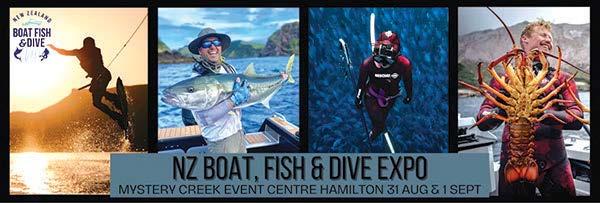
Between 2002 and 2011 the Waikato region treasured having The Boat, Fishing and Leisure Show, which at its peak attracted around 23,000 attendees! For 12 years now the region has not had the privilege of enjoying such an event. After many requests we are very excited to bring the region its very own boat show once again in the form of The NZ Boat, Fish and Dive Expo which will be held on the 31st August - 1st September 2024 at Mystery Creek
Events Centre, Hamilton!
If you are in any shape or form interested in any water based sports from boating to fishing, diving, spearfishing, kayaking, wakeboarding, skiing, jet skiing, seafood or the culinary preparation of it, then this is one event you cannot
Get ready for an absolutely epic weekend celebration of all things on, in or under the water!!
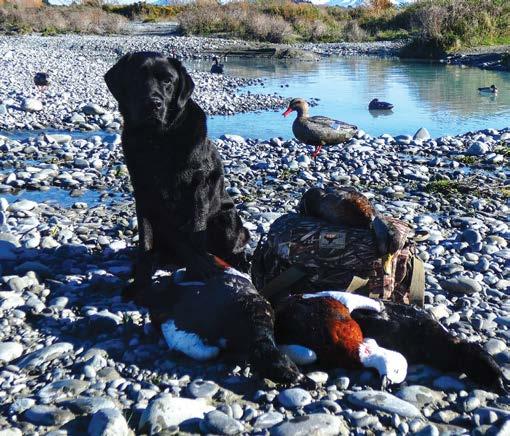
sorted, I heard some paradise ducks, I jumped on my Cupped Wings Paradise Call while trying to work out where they were They were coming from behind me, so I quickly jumped around and shot two of them before I spun around again and got the third heading away. This last
bird landed over a tree bank on the other side of the water
This would be a bit more of a challenge for Ace, but he saw it fall and knew where to go lead and he ploughed through the water and bush on the hunt. As I was completely blind to see him, I had to
Come and make a
trust he was doing as he should. It didn’t take long for him to come back with the drake in his mouth. It was a super proud dog dad moment.
This was the last bit of excitement for the morning, but to me, it shows there is value in every hunt I get out to do
Door Prize info
Buy a ticket to the NZ Boat, Fish & Dive Expo and go in the draw to WIN our awesome door prize valued at $22,000!!!....An epic 7 day Fiordland Adventure for 4 people with the Get Wet Waikato crew onboard the vessel Legacy! A once in a lifetime trip filled with incredible diving, fishing, hunting, amazing scenery, scrumptious seafood dinners and of course lots of laughs and good times! *Some t's & c's apply.


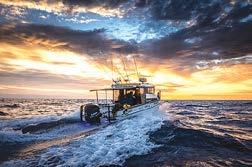
TICKETS
Adult 1x Day Pass - $25.00
Children 14 & under - Free Saturday 9am - 5pm & Sunday 9am - 4pm
Scan here for ticket purchase


The Pulsar Merger LRF thermal binocular delivers a comfortable, immersive viewing experience with enhanced detail rendition.
Viewing with both eyes also reduces eye fatigue during prolonged observation periods
Pulsar Merger LRF common features
• 1000m laser rangefinder
• Lynred STD -810/833 T WS Qualified sensor
• Supplied with an APS3 battery and charger
• Quick-change battery with internal back-up battery adds significant operation time
• Tough waterproof magnesium alloy housing Overidable proximity sensor
• ¼” tripod mount
Three models available to suit various budgets and operational requirements
Merger LRF XQ35
All the great features of its high-end siblings. Compact, great image quality, fog , rain and foliage penetration. Excellent value
Merger LRF XP50
The most popular Merger combines fine image detail with deep fog , rain and foliage penetration. The best all-round Merger for Pros and hunters.
Merger LRF XL50
The ultimate thermal o ers a ver y wide field-of-view, amazing image detail and high magnification zooming capability.


Kingfish have long been a top target for my kayak fishing but when one hits your light setup, you had best be prepared!
Targeting large gurnard and snapper on kabura’s in deep water often produces interest from a great many species. One of the ‘bycatch’ species are kingfish. Typically, more prone to large knife jigs and live baits, the kingies this year seem to love nothing more than destroying a falling Black Magic Sunakku over a deep
With a wiggling luminous skirt and brightly coloured head, I can’t blame them for having a crack. Even small kingfish kick into 6th gear on the strike, leaving my poor reel to lose line at huge speed and my kayak to get

dragged along behind. The bigger the king the closer you are to being spooled. On several occasions I’ve watched as my backing
came into view, but thankfully these occasions were right after the scorching run faded.
These fish are looking for any weak point, especially that knot you may not have tied perfectly
the long task of moving
the reel to gain extra pressure on the lift before dropping the rod down to begin the next one. If the kingie decides to run, I have a perfect drag set to keep the fish pinned.
The fight with the kingfish somtimes takes up to 30 minutes after hook-up. Many I have caught have been around the 10kg mark which are a huge challenge on the light platform.





On light 10 -20lb equipment, I fight kingfish patiently, especially in the deep water I find myself hooking them in. My hooks are small, leader light and braid exceedingly thin.
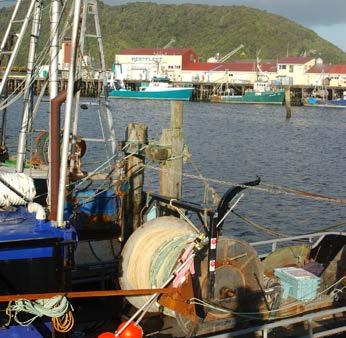


After the first blistering run, many kingies settle into steaming along at pace, usually at just the right speed to tow the kayak behind. This is to my advantage as each moment the fish tows me along is more power removed from that huge yellow tail.
Once the fish tires, I can begin
This is easier said than done on such light rods with limited leverage. As tempting as it is to tighten the drag, it’s better to enjoy the scrap and make sure that the kingfish comes to the surface rather than it ending in tears when the hook wears a hole in the mouth before popping free
Slowly I can make ground up the water column, thumbing
It’s very rewarding to consistently land them when things can get so out of control at the outset of the fight. Thankfully a good many of these are hooked away from the rocks, so the only worry is sharks coming looking.
On a recent battle a mako made the end of the fight quite hairy as the kingfish rushed to shelter under the kayak as the big shark tried to eat an easy meal!
Thankfully I was quickly able to get the fish onboard and released away from the big predator, Just in time!
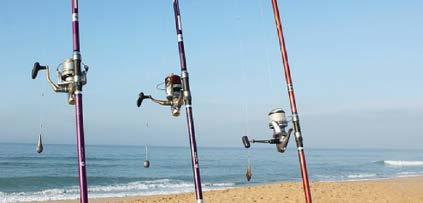
It’s amazing the number of Kiwi hunters who dream of hunting Africa. “It’s on my bucket list!” Is what I typically hear.
It’s also amazing the number of Kiwi hunters who never get past the dreaming stage, which is a genuine tragedy because it’s a lost opportunity
An authentic African safari surpasses even the most wildly optimistic hunter’s expectations and leaves you with lifelong memories.
Most safari hunters dream of taking the iconic kudu—the grey ghost and called that for a reason: nature has blessed it with the ability to vanish in plain sight. It is truly an impressive creature; elegant, stately almost, graceful and yet indomitable of spirit. It’s towering spiral
horns and ‘fingerpainting’ face markings make it one of Africa’s most mesmerising antelopes.
that first ‘sundowner’ after a long dusty day on the trail.
Over the past decade, I have

But of course, there are many more plains game animals to target-something like 40 plains game aloneand that is what makes a hunting safari such an experience-that and the wild scenery, beautiful native locals, the culture, the smell and the crackle of the campfire at night, and
organised many safaris to the Dark Continent and no hunter has returned disappointed. In fact, many have returned to Africa multiple times. There’s an old African saying: “Everything in Africa bites-but the safari bug bites worst of all!
I have organised


a special group safari to East Cape Karoo for 2025; a wildly exciting destination and very The advantages of joining a group are numerous: the organising is done for you; many of the fixed costs are shared and safaris are always best enjoyed in the company of others. The camp atmosphere is amazing. We use authentic safari tent camps or small bespoke lodges that appeal to Kiwi hunters. Our operators are professionals who have been in the safari business for generations and the wonderful. Warm, friendly and generous. Most importantly, the hunting is sublime Stop dreaming…
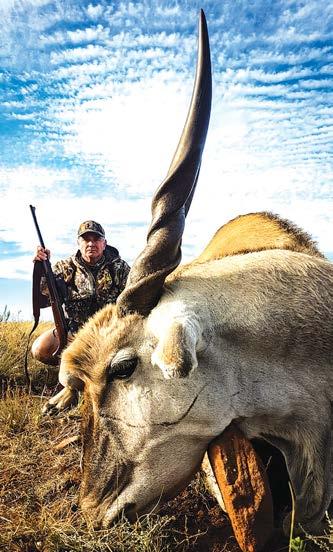
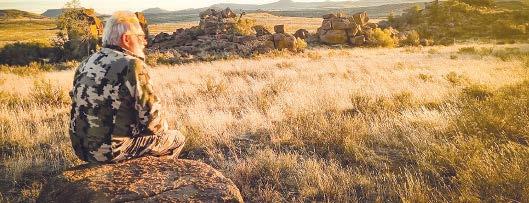

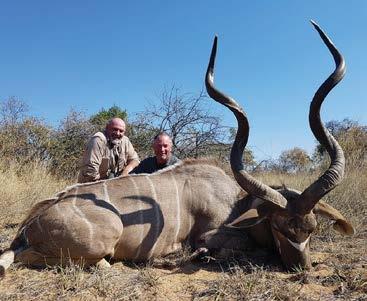


The old bones have fair been creaking over the past week or so as my part of the country has been assaulted by cold, wet and foggy weather. The easterly set is both cruel and kind where I am – it holds the rain and fog tight to the hills above my home (Gunyah – for reasons I can explain some other time) but blows a constant
the sea out front is flat and glassy other than for an occasional sou’west swell pushing in from the Chathams. In those conditions the coastal population expands as the surfies from the city hit the coast for the duration of the swell.
I went down to take a look at the action the other day – a swarm of rubber clad diehards bouncing around on the peak waiting for the one wave that they would no doubt be reliving and boasting about well into the night. Skill levels were definitely variable and I could not help but thinking that the ice cream headaches would be keeping the surfing sessions very short. There is no sign of global warming down in the Bay at
this time of year – sea temperature was single digits for a few days before bouncing back to the season average 12 degrees – but that in turn was a few degrees warmer than the temperature on land. It’s not often we see frost on the lawn across from the boat ramp, but there you go – twice already and we are not into real winter yet.
The commercial blokes have been going out but not too many recreational vessels launching recently. The lobster catches have been pretty good – for some of the professional operators June is a very productive month if they can get a good run at it. Being able to get consecutive days at sea is a real bonus for lobster fishing because you have an opportunity to get onto to the elusive critters. It’s a male-only gig too – all female lobsters will be in berry now and fishermen set gear to avoid them as much as possible. The male lobsters are entering their moult phase so they will be feeding up to store the energy they need to shed their old shell and hide themselves away whilst
the new shell hardens up They are especially vulnerable to predators during that moult period. Locally it is blue cod, school sharks and rig that hoover up lobsters as a matter of course
shells no bigger than the thumbnail of a grown man. When I was paua diving for a job I would watch the moki going head down with their backs almost out of the water as they literally sucked those

You get all sorts of
the Bay. There are some big moki straying in close when the water is cloudy and the surfcasters land quite a few good ones
down from my place I reckon the biggest and the fattest of the moki are taken by spear fishermen who find them seemingly drifting on the surges that run up the rocky gutters very close to shore. Moki caught invariably have a gutful of tiny paua
rocks. And a few blue cod would be cruising in attendance trying to pick up whatever scraps that came their way
We have a local shark population too – not those smaller varieties, but the serious ones. Over the years as a commercial fisherman and diver I have blundered into sevengilled sharks that were sitting in that cloudy
Tuna Tartare
250g cubed Tuna
50ml Mirin wine
vinegar
1 tsp fresh ground
ginger
50ml sweet chilli sauce
Juice of one lemon
Avocado Salsa
2 diced avo’s
¼ cucumber diced
1 chopped spring onion
1 tsp crushed garlic
½ tsp Smoke & Spice
lemon seasoning
Dash of olive oil
Crispy Panko Tuna
250g Tuna cut Goujon style
Kewpie mayonnaise
Panko breadcrumbs
½ tsp Smoke & Spice lemon seasoning
Dumpling wrappers
Method
For Tartare and Salsa gently combine ingredients and layer with Avocado salsa as the base and tasty
Tuna Tartare on top
For the Crispy Panko
Tuna coat the Tuna in Japanese mayo
hapless moki that were no doubt feeling very satisfied with their paua feast and not paying the prowling taxman. Further out the visiting white pointers were an incentive not to dive near the seal colonies. They were also a nuisance when we were netting for butterfish. On several occasions my crewman and I had to unroll some reasonably large whites from our nets as we retrieved them. One memorable occasion we had fourteen feet of twisting, squirming and snapping white pointer hard in alongside my little sixteen foot double-ender which had not much freeboard because the up a good freight of butterfish. Brute force, a sharp knife and careful avoidance of big ripping teeth enabled the release of the shark but cost me quite a few days of having to repair and re-sling the net.
Which brings me back to the surfies – all encased in rubber with arms and legs dangling in the cold ocean. The peak down at the Point has always been a very fishy place. It is coincidental that it is
spot in a good swell. It is also coincidental
www.smokeandspice.co.nz
that butterfish nets have snagged at least three white pointers on that reef over the years – two of which were released; one of which was landed because it was dead in the net. It was so large that the skipper and crew could not get it on deck and had to lash it alongside their vessel. An eighteen foot boat with two feet of head and jaw at the front end and two feet of tail at the stern steamed slowly back to the ramp. It took a small crawler tractor to drag sharkie up the beach. A crowd gathered to watch the landing – an auction almost immediately commenced with two of the bystanders competing to buy the massive jaws and a local fish wholesaler willing to buy the shark for the fish and chip market once it was gutted. You could do in the day – ‘waste not, want not’ if a net fisherman could not avoid a big shark mortality. Not sure now if that was a good thing or a bad thing. Oh – and remind me to tell you about Gunyah
A little party favourite this time that can be used for any sashimi grade fish,crispy panko bites of Tuna accompanied with a Tuna Tartare on an avocado salsa with fried dumpling wrappers to load.
(Kewpie or homemade) and gently cover in Panko breadcrumbs.
Fry quickly until brown but still pink in the middle
Use the remainder of hot oil to crisp up dumpling wrappers using them to scoop up the Tartare.Enjoy with a crisp lager!
Marcus Peters
Int’l Kiwi Chef
Quite good with a gun and rod

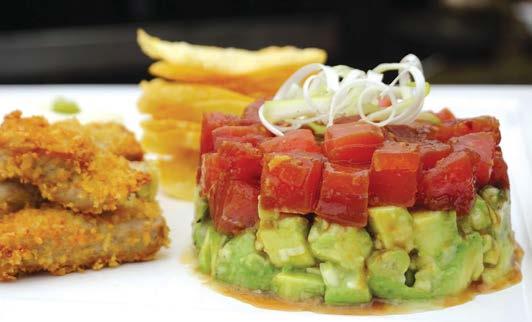
It was a windy Saturday night on the Wairarapa coast but that didn’t stop over 100 intrepid chefs (and helpers) from arriving at the Waimeha Camping Village to serve up their wild kai and sample others’
With four categories up for judging we sampled seafood, vegetarian, meat and desserts – all with a wild kai focus.
The winners were:
KAIMOANA: Lee-Rose
Locke - Seared blue fin tuna
VEGETARIAN: Sheryl
Rodderkirk - Kumara fries & kawakawa & watercress pesto and mayo
MEAT: Sheryl
Rooderkirk - Venison
& field mushroom dumplings with watercress broth
DESSERT: Donald Addis - Upside down pear cake
OVERALL SUPREME
WINNER: Sheryl Rooderkirk
Huge thanks to the sponsors who are always there to support local community events King & Henry, Scotty’s Meats, Pain & Kershaw, Steinlager JP had a bit of stage

fright as he welcomed all to the night but soon relaxed and was able to celebrate what is sure to become an annual event.
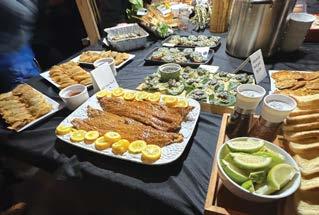
Sometimes the unexpected things in life bring delight and add piquancy to our existence.
I was sitting on the admiring the day, the weeds in the raised beds and thinking how nice it was to wear sunglasses after a rare few days of rain. Here I was on the Coast, when a sudden thought wormed its way into my brain. Fishing!
It was certainly a decent day, the boat was ready, and the lake awaited as it always does, so the cuppa was drained, bung checked, ratchet tie down tightened and it was latch on and away Yes, it was winter but the sunny hours across the top of the day before late afternoon chills creep in are a mid-year gift. It happens, because southerlies make life a bit unpleasant on the east side of the island, but they drop their wetness and


fade to virtually nothing when they reach our western climes. When Canterbury gets a northwesterly draught, story for another day
The lake was quite a picture and I had it to myself, while the sun meant the jacket and jersey soon came any movement and cast into nooks and crannies. Before long there was a slight ‘wobble’ in the still water of one of the nooks, so a hopeful fly went out. Swirl, thud,
rod bend, then under log it darted to swim away free. Ah well, if yuh got everyone it’d be called catching. Some quiet oar strokes along the margins to where a fish was clearly feeding in the shallows so out went the fly, which was duly ignored. It continued feeding, so I made another cast and the feeding stopped, with the bow wave indicating its passage to deeper water I returned to the oars but found they were grounded and had to
use one of them as a punt pole, a bit like the chaps from Antigua boatsheds on the Avon. Some heaving that sit in the water and the Silver Frog was free once more
The floating stalk continued along the edges and sedges with fish making their presence known by a fin or tail appearing and a short time later, a small swirl, thudding weight – in again.
A reasonable 4.5 pounder came to the net and was released, which made me glad of the trip

Like most anglers we have our favourite spots on Brunner – places where we’ve done well over the years, however they don’t perform every time we visit

them.
I was once told by a seasoned fishing guide to move if there’s no action or interest as fish only go where there is food. Food for thought.
Further along the lake featured water that went in behind the reeds so in I also went, recalling great days of the past. Yes, there were fish to be seen but not hooked as in the thin water they had become cautious. Hmm, what to do? A little light bulb glowed briefly above my head
deeper water I went. Picked up a modest but very angry and active specimen that the boat – another
strategic in lake release!
Next it was into an inlet that might have once been an old creek mouth, where I had a good solid take followed by a spirited battle and a release. This is good I thought, so ventured further in to have a bow wave as a trout went for the fly. The fight was hard but short as it flipped out the barbless and
The clock and the temps began to conspire against further fishing, so with thoughts of what still needed to be done to get home, I pulled the plug. Another West Coast winter day well spent.
The Government has announced that handheld thermal imagers are now legal for use in DOC managed land. This is very welcome news for improving hunting success, animal recovery, and above all, target identification and background safety It must be noted that thermal imaging devices that attach to a rifle and night vision optics are still prohibited, as is shooting in darkness. Therefore, only handheld monoculars and binoculars are allowed.
The ability to use a thermal imager has the following advantages:
Safety
Though accidental shooting incidents are low, they still happen. Most accidental shootings occur at close distance in wooded terrain, when a hunter has limited vision and responds to movement. Not identifying a target is a fundamental breach of the safe handling of firearms. However, humans have a fatal flaw, because the
brain can falsely add information. For instance, someone who believes in the existence of UFO’s or ghosts, are more likely to see one Imagination is one of the most human attributes of our brains, driving our evolution to where we are today. However, it is a massive disadvantage for some whilst hunting.
Using a hand-held thermal imager does not negate the need for positive target identification, but is another aid for doing so. Humans are upright critters, while the game we shoot are horizontal, a thermal imager at the distance where most accidents occur will reveal this.
Animal recovery
A thermal imager is very good for tracking blood trails and finding dead or wounded animals is both humane and convenient.
Hon Todd McClay Minister for Hunting and Fishing

31 May 2024
Handheld thermal tech now allowed on public conservation land
Technology making it easier for hunters to find animals will be allowed on public conservation land from 1 June, Hunting and Fishing Minister Todd McClay has announced
“The use hand-held thermal technology to search for animals during daylight hours will increase hunters’ chances of coming home with an animal for the freezer,” Minister McClay says
Thermal technology which can be attached to a firearm is still prohibited , and discharging a firearm when it’s dark or using night vision optics is not allowed on the DOC estate
“Hand-held thermal technology, which finds heat sources within vegetation cover, has become widely available and is increasingly used by hunters for both safety and to improve the chances of detecting an animal
“Hunters will then still need to identify their target beyond all doubt before taking their shot.”
Minister McClay says visitor safety was carefully considered when making these changes, which have been discussed with the Land Safety Forum
“I encourage hunters to understand and follow the conditions of their hunting permits and the Firearms Safety Code to make sure everyone enjoying New Zealand’s stunning wilderness returns home safely ”
DOC prohibited the use of thermal technology on public conservation land in 2010 At the time, the technology was not readily available and not well understood
“This is just one of the ways we’re working to make life easier for hunters Work is also underway to make getting a hunting permit quicker and easier – we’ll have more to say about this as the work rolls out,” Minister McClay says.
Spotting Spotting game in the evening before a morning hunt provides a great heads-up as to their location without causing any disturbance. Improved hunting success leads to more meat in the freezer and less need for culling and poisoning. Take advantage of the opportunities and benefits that a
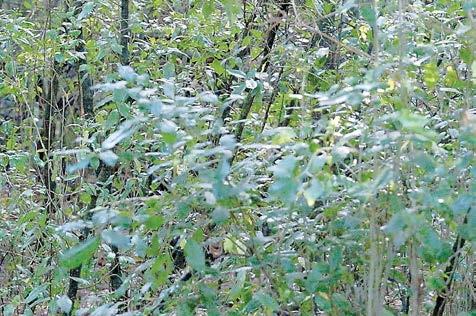
handheld thermal
our website to see the finest range of European made thermals, chosen by professionals throughout New Zealand. Visit: www advancedoptics.nz

As seen with a Pulsar thermal imager Would you mistake this for a
The single biggest risk to recreational fishing is that fisheries managers are too accustomed to managing recreational fisheries with guesswork, and the lack of reliable and timely data makes that possible.
This is ironic given Fisheries New Zealand (MPI) spends on average over $1 million annually to collect such data.
Most of the annual budget for recreational data collection is spent on the National Panel Survey, a nationwide household survey undertaken every five or six years costing $5 to $6 million.
Most of the Survey’s funding is used to find people who fish and are prepared to
record their data for a one-year period.
Note: Fisheries New Zealand does not hold a database of fishers to randomly select for lower-cost survey methods.
The main problem with the Survey, is it has limited several South Island regions, where most of the fishing is done by people in transit; transient fishers are not well represented in a household-based survey, and so the results are far less certain.
Also, the Survey results are uncertain due to high extrapolation of data in estimating areawide total catch of certain fisheries (generally based on data from one percent
of estimated total fishers in an area).
The five to six year interval between surveys is problematic for management purposes, as a fishery’s characteristics can change rapidly. The management change process needs to be adaptive and timelier. This prolonged situation has caused recreational fisheries to be managed largely on guesswork. The lack of data or poor quality data inevitably leads to recreational fishers’ interests being subordinated, ignored or disadvantaged in other ways. This is a mockery of the fact that collectively recreational fishers harvest

I keep coming back to the world of fishing to see what I can find,
The deeper you go the more chances you get to encounter something out of this world.
I found myself 7 kms out to sea on a kayak. The area I fish out here is known as ‘the drop-
increasing to a flat and sandy bottom, there is no reef to hold the fish in the area only food, current and the depth change Year round a wide range of fish can be found here.
It was a full moon and the current was ripping in a southward direction making it a challenge to get my hooks down to the fish
a significant portion of the total catch, particularly in inshore fisheries, which can adversely impact catch rates for the other fishing sectors and contribute to localised depletion.
Excessive recreational fishing has led to some fisheries having their sustainability at risk. Classic examples include the South Island blue cod fishery, particularly in the Marlborough Sounds, Motunau Beach in North Canterbury and more recently the paua fishery in the Kaikoura region (PAU3A).
A related scenario is the lack of available data could lead to valued fishing grounds being



on the slope. I had to resort to 200g Kabura heads and 8-ounce sinkers just to keep some contact with the bottom.
The fishing was tough
closed. A classic example is the proposed no take marine protected areas (MPAs) for the Otago and Catlin coasts.
We still await the Government’s response to the previous administrations decision to establish six MPAs. There were objections to the adverse impact caused by the MPAs, but with little data available, DoC was able to ignore the objections when advising Ministers.
The result being that important recreational fishing opportunities with safe access could be lost, while alternative opportunities pose greater safety risks and potential intersectoral tensions and conflicts.
For these reasons, Fish Mainland Inc, with the financial support of MPI’s Sustainable Food & Fibre Futures fund and the Myers Foundation Trust, developed

and sign was mostly scarce. I reset my drift regularly so that I wouldn’t be swept too far down the coast. The only way to stay over fish was to paddle into the current while lines are out, making this a balancing act.
On I fished and
the Mainland Catch app https://www fishmainland.nz/ mainland-catch-app
This intuitive, easy to use app, and resultant database, is the next best step in improving recreational fishing and the management of fisheries – without more reliable and timely recreational data, no further steps are possible
Finally, we would like to acknowledge Stephen Logie, Chief at MPI’s Invercargill retired after 47 years of public service

Stephen embodied what we consider
public servant. He was generous with his knowledge and insights for numerous groups and individuals involved in fishing, including the Fiordland Marine Guardians. We wish him well. He will be missed in the Southern region.
eventually a number of spread out marks appeared on my screen signaling I should drop down to them. Out from under the boat came a long silver fish and it was excitement as the fish was a frostfish!
The comically sword shaped fish, possibly the most reflective of all fish species. It measured just under 1.5 metres and had a
rear I had been lucky to land this one, my other hook had been frostfish in the school. Catching weirdos like this out here is what keeps bringing me back for more and I cannot wait for the next unusual fish rising to the surface on my line.
Fisheries New Zealand is inviting feedback on proposed changes to catch limits and other settings across a range of Aotearoa’s fisheries as part of its regular sustainability reviews.
Director Fisheries Management, Emma Taylor, says every six months we review a range of fish stocks around the country and develop proposals focussed on their longterm sustainability “In this review, options include increases to catch allowances for twelve fish stocks where information suggests more fish can be sustainably harvested. We’ve also proposed reducing catch limits for five fish stocks to support their ongoing sustainability ” Proposals are based on the best available information about the fishery, including scientific assessments and feedback from local fishers, iwi, and other stakeholders.
The full list of fish stocks included in this review can be found by
scanning this code.
An in-depth scientific report has found a mix of complex climate factors are likely causing Milky White Flesh Syndrome, says Fisheries New Zealand.
Fisheries New Zealand will analyse the submissions and provide advice to the Minister for Oceans and Fisheries for consideration. Any changes will be announced by the start of the fishing year on 1 October 2024.
“The consultation is open now, and we encourage everyone who has an interest in these fisheries to have their say,” says Emma Taylor
Submissions can be made online until 5pm on Friday 26 July 2024. More information including how to make a submission can be found here: https:// www.mpi.govt.nz/ consultations/reviewof-sustainabilitymeasures-for-fisheriesoctober-2024-round/ or scan the code above
Fisheries New Zealand’s director science & information, Simon Lawrence, says snapper with the condition appear to be skinny and have mushy, white flesh rather than their usual translucent, firm flesh, and are malnourished.
“Early and ongoing tests ruled out exotic disease and food safety issues, meaning that fish with the syndrome are still safe for people to eat if they choose to
“The evidence suggests a complex interplay between factors, including extended La Niña weather patterns and warmer waters causing lower production of the phytoplankton and zooplankton that provide important food sources at the bottom of the food chain.

“This is a complex issue, and is more likely to be due to weather patterns and natural changes in fish biology throughout the seasons. Prevalence of the syndrome appears to be declining which supports these theories.
seeing more snapper in the Hauraki Gulf for some time. The fishery is abundant, with plenty of younger fish entering the stock, all competing for food.
“Commercial fishing main food sources of snapper. They’re opportunistic feeders and are unfussy about what they will eat ”

“Warmer ocean temperatures may also metabolism, meaning they need to use more energy and require more food ”
Mr Lawrence says the report found that a lack of food was the likely cause of the syndrome, but there was no evidence to suggest that fishing was the cause of that.
“Overall, we’ve been
Mr Lawrence says the areas in the Gulf where bottom trawling was permitted did not correlate with the areas where the syndrome was most prevalent.
The National Institute of Water and Atmospheric Research (NIWA) undertook research on behalf of Fisheries New Zealand and collected a range of data, including information from commercial and recreational fishers and where it had been caught.
The syndrome has been most prevalent throughout the inner Hauraki Gulf, near Auckland, and around Doubtless Bay near Northland.
Researchers considered data gathered from fishers together with environmental information, such as sea surface temperature, to determine if any changes had occurred in the period before fish with the syndrome were seen.
“The report underlines this complexity and its insights will be used in future fisheries assessments,” Simon Lawrence said.
The full report is available on MPI’s website www.mpi. govt.nz or scan link.


Brian Bishop
The number of folks traveling to speed steel events around the country is growing, and with good reason.
Cost wise it’s a good return for the time and money spent. You can get to shoot a number
firearms at each event. The down side is you will be shooting a lot of rounds, which doesn’t suit everyone as some like to stretch their ammo to last as long as possible. This is not the case for most of my friends, we are kind of the other way and like to shoot as much as we can get away with, without getting in too much trouble at home due to the cost of the ammo at the moment. As the name suggests,
we shoot steel plates and we do this as fast as we can.
your score. The same goes with any misses before the stop plate is hit. Some very
with a good following. The targets are set to a precise layout, it is easy to see how you
Distances vary from the shooting positions to the targets out as far as 35 meters, and

Some guns are drawn from the holster while others are already in the hand. On the start signal five plates are shot with the last being the stop plate, this must be shot last otherwise a time penalty is added to


good times are being done at speed steel. Like IPSC everyone competes together and no inch is given or asked for between genders. Speed steel is an international sport,
fare against others and also how you are improving. Extra shots cost you big time, so the old saying fast is smooth and smooth is fast really comes true here, because even the smallest mistake can cost big time as the seconds tick by.
while the plates aren’t all that small, they aren’t that big either , other than the large squares. Of course, even a big white plate can be missed when you try and go too fast, with this style a hit is a hit so no need to go for centre, just hit and





move. You get five runs in most cases and the four best times count, so fast and steady is the key because two or three fast times just won’t cut it, four good times are required.
As there are .22 used in both pistol and rifle it can be a cheap way to try and get into speed steel, followed by a 9mm production pistol which is an out of the box without big expensive add ons or changes.
Why not give it a go?
Contact a pistol club in your area, or have a look at the Pistol NZ web site at the nine
On a side note, I would like to take the opportunity to thank Tactical Solutions for their support of the Cable Bay members who are traveling to Bali in August for the Australasian’s as part of the New Zealand team. Look out for a write up about this event in the future


•
•
•
•
•
•
•
•
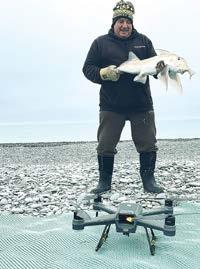

WE
IN
KAIKOURA, NEW ZEALAND
Join us aboard our purpose built 6.2m Osprey Boat, “First Light”. Your fully quali ed skipper, Malcolm Halstead, has 35 years’ experience shing in the waters of the South Island of New Zealand. It is Malcolm’s goal to make sure you have a memorable shing experience while visiting Kaikoura. Also available
Freediving trips - Take a kid shing Ladies trips - Game shing for Sharks CALL AND BOOK A TRIP TODAY
Mobile: +64 21 843 908 Email: info@topcatchcharters.co.nz



















